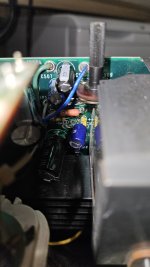I bought a Vectrex (3GE version) a while ago and when I received it the unit would power on, and I could hear sound but there was no image. I traced the fault to the power/volume switch. Rather than take the switch apart and clean it I bridged the two terminals on the back so that, when switched, the switch would deliver power to both the logic and monitor circuits. I've since read this is a common problem with the switch and while it's probably better to clean it, this method seems to work fine.
Having done that I decided to recap the machine. bought the caps, carefully replaced one at a time, as I have done on many systems over the years, but now whenever I turn the machine on it runs fine for a short time BUT then blows the internal fuse (250mA T). Generally this is after a minute or so or though I haven't timed exactly. If I replace the fuse, it all works fine again for another minute or so. I've gone through about 10 fuses in the last week but still haven't found the problem. As I didn't spend much time on the system before the recap I actually don't know if this existed before the recap or not. Yes, learning has taken place - properly test the system before tinkering with it too much!
Checks so far:
My plan for next steps is to try isolating parts of the power board to see if I can identify which part of the board is an issue. Does this sound reasonable? I've attached an image showing where I plan to tackle this issue (not by making physical cuts to the traces but by removing components).
If anybody has any advice/guidance or a fault-finding workflow for this I'd really appreciate it as I've not worked on a Vectrex before so am not familiar with it.
Having done that I decided to recap the machine. bought the caps, carefully replaced one at a time, as I have done on many systems over the years, but now whenever I turn the machine on it runs fine for a short time BUT then blows the internal fuse (250mA T). Generally this is after a minute or so or though I haven't timed exactly. If I replace the fuse, it all works fine again for another minute or so. I've gone through about 10 fuses in the last week but still haven't found the problem. As I didn't spend much time on the system before the recap I actually don't know if this existed before the recap or not. Yes, learning has taken place - properly test the system before tinkering with it too much!
Checks so far:
- As this seems to be time related I had suspected an issue with the capacitors so I have checked the values and orientation of all capacitors on the logic and power boards and it all looks good to me, aligned to the info on the Console 5 website. Initially I had fitted a standard cap instead of a non-polarised version to C409, but I have corrected that now and the fault persists).
- For the period the unit is running the voltages on J204 are fine (-5, GND, +5, -13)
- I have unplugged the logic board and speaker and the problem is still there so I'm confident the issue is somewhere on the power board.
My plan for next steps is to try isolating parts of the power board to see if I can identify which part of the board is an issue. Does this sound reasonable? I've attached an image showing where I plan to tackle this issue (not by making physical cuts to the traces but by removing components).
If anybody has any advice/guidance or a fault-finding workflow for this I'd really appreciate it as I've not worked on a Vectrex before so am not familiar with it.



